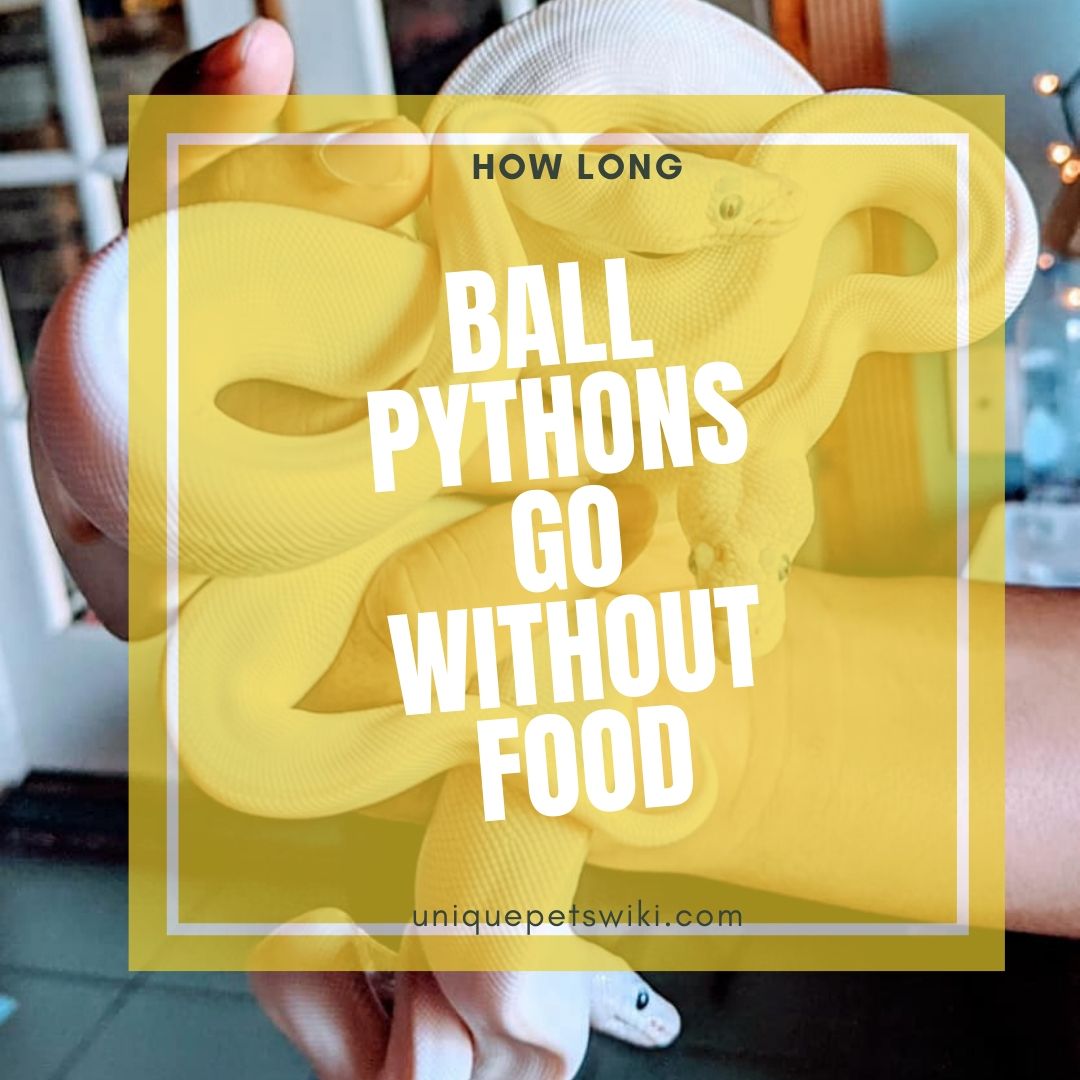A ball python is a great pet, but it is very concerning if they stop eating. You ask yourself, “how long can they go on for before they stave, and will they start eating again soon?”. Now we will discuss the asnwers to the question, how long can a ball python go without eating.
You have come to the right place to answer these questions since we have figured out how long they can go without food and other interesting snippets about this gorgeous creature.
Contents
- Why Did My Ball Python Stop Eating?
- How Long Can A Ball Python Go Without Eating?
- Lower Metabolism? Why?
- The Way Snakes Digest Their Food Is Mesmerizing
- Other Factors of Digestion
- Ball Pythons Have Other Awesome Survival Skills
- Can I Force My Ball Python To Eat?
- What Else do I Need to Know About Feeding Ball Pythons?
- Conclusion
Why Did My Ball Python Stop Eating?
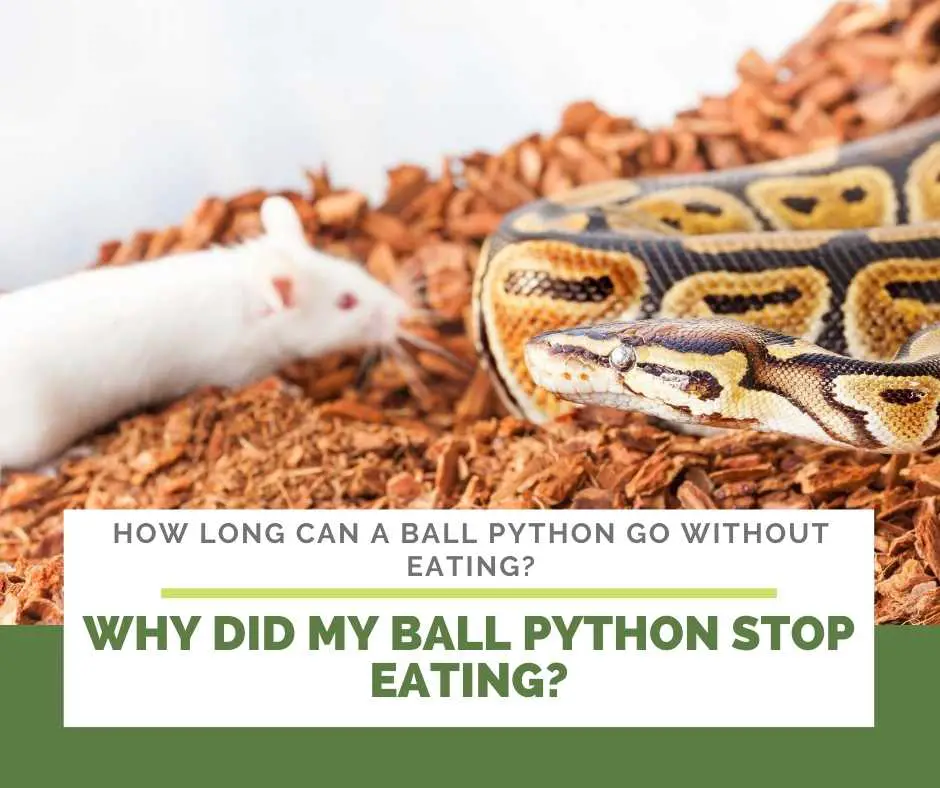
A pet ball python is often an easy snake to look after. This is why it is a favorite among first-time snake owners. However, there are a few things that can go wrong. And a major one is when your pet stops eating. There could be a few reasons for this.
The Tank/Environment Is Too Cold
Ball pythons need some heat so that they can swallow and digest their food. If it is too cold in their tank, they cannot eat even if they want to. Therefore, you should check the temperature, warm up their tank with a heating lamp, or move it into a sunny spot.
They Are Shedding
Your snake may not want to eat while it is removing their old skin (shedding). You would know when a snake is about to shed due to their eyes looking milky and their skin looking dry and rough. Once their old skin is off, they will want to start eating again.
They Are Picky
Ball pythons are like humans. Not every python is going to eat everything. There is a chance that your snake just does not like the smell, look, size, and how it was prepared. If it was frozen, if it was pre-killed, if it is alive, etc.
This would require some experimentation to figure out what they want and to stick to it.
They Could Be Sick
Often when animals get sick, they do not eat. This could be the case with your ball python. They could have gotten ill and should be taken to the vet for a checkup.
However, there is a chance that they could have gotten intestinal parasites.
This can make them feel sick and lose weight. The way you can check is to take a sample of their droppings to the vet, so they can test it for worms and other parasites. However, if they do not move, take them to the vet as is.
They Are Stress
Stress is a killer, not only for humans but also for reptiles and the rest of the animal kingdom.
Your pet ball python could be stressed due to moving to a new place, having new roommates or you handle them too often. Hopefully, with time they will be fine.
How Long Can A Ball Python Go Without Eating?
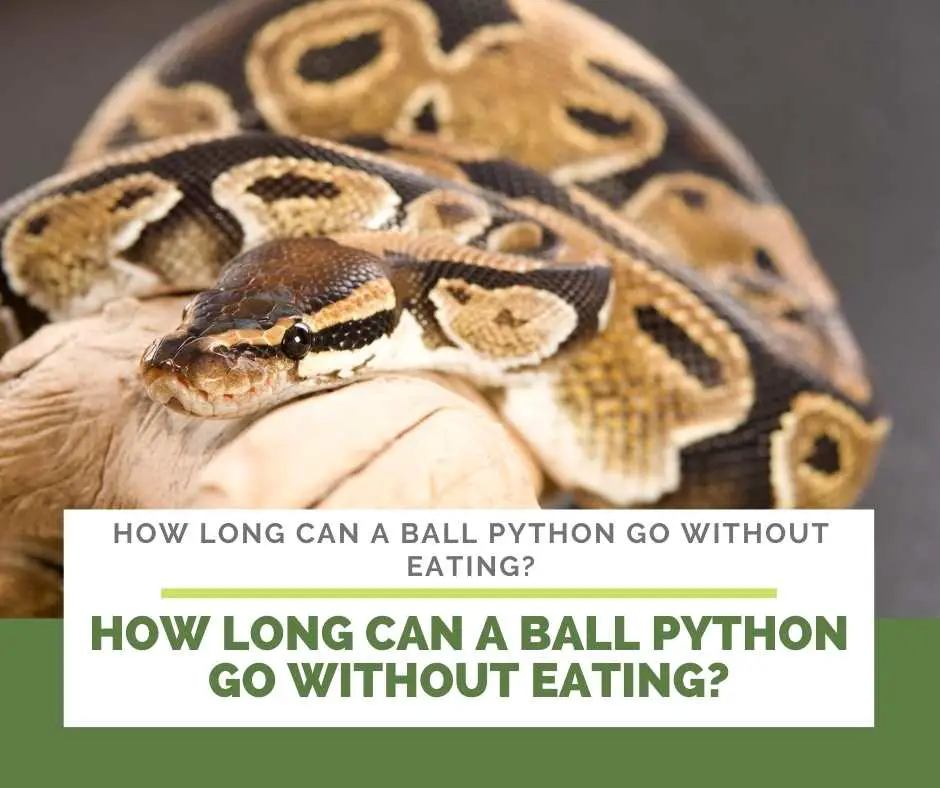
Ball pythons are fantasizing creatures about how their bodies can handle food or the lack of it. Healthy adult ball pythons can go for about half a year without any food. The time baby and juvenile ball pythons go without eating will be shorter, about one month.
When we say without food, that means no snacks or anything.
Baby Ball Python
A baby ball python goes from the age of zero to about four months old. However, they cannot survive without food for long. This is because they are still developing and growing. The baby ball pythons can go without food for about two weeks to one month.
Juvenile Ball Python
They go from the age of 4 months to about a year. You should pay attention to how often they want to be fed. Not as much as babies but maybe more than adults. Therefore, the juvenile ball pythons can go with food for more than a month, maybe a month and a half.
Adult Ball Python
Adult ball pythons are from the ages of one to 30 years old. They reach their full size by three years of age. In this phrase, they are fed about once every ten to 14 days. As mentioned, they can go for half a year with no food.
Their bodies adjust to the lack of food by using the energy they have stored away and conserving their energy. They achieve this by lowering their metabolism rate. Food gives energy and since ball pythons can store energy for emergencies they can live without food for a long time.
Lower Metabolism? Why?
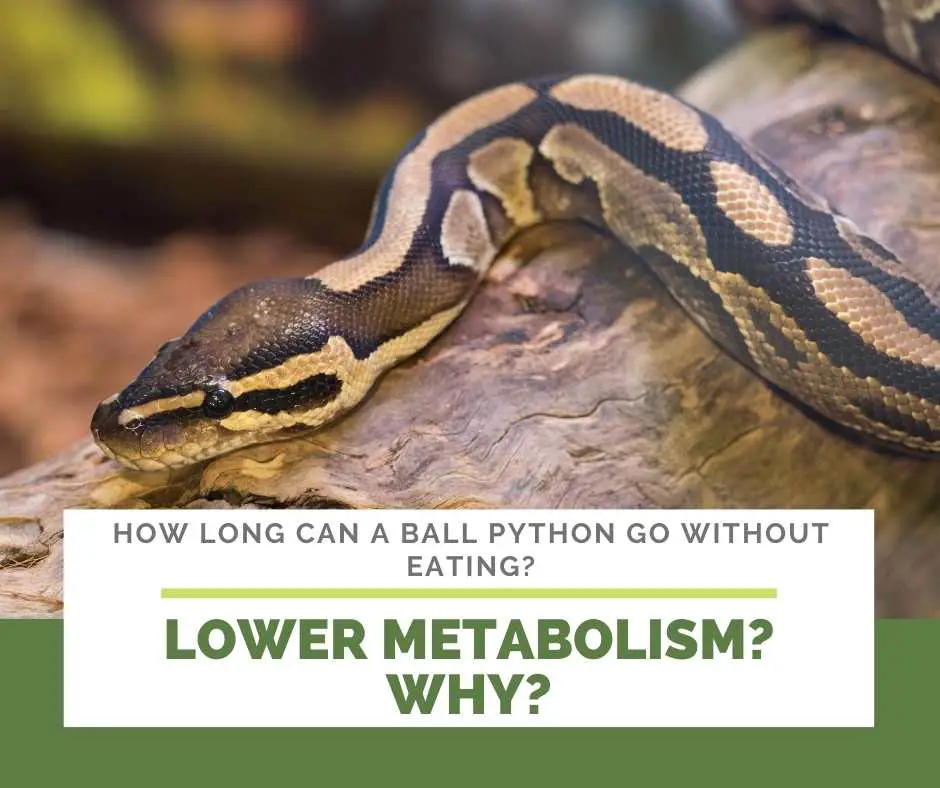
Snakes (not only ball pythons) can lower their metabolism by about 70 percent. However, regarding ball pythons, in particular, they naturally do not use that much energy regardless of the season and location. This could be because ball pythons do not use much protein unless they are eating.
Therefore, they can save and regulate their energy. Plus, adult ball pythons can go without water for about 12 days with no negative repercussions.
They could have adopted this system of survival due to the winter months when their food (rats, other small mammals, lizards, amphibians, birds, and other snakes) is almost impossible to come by.
Either everything leaves in winter (like birds), hibernates, or goes into finding to gather heat. Winter is a hard season to find food, so ball pythons have adapted by lowering their metabolism and using their reversed energy.
This happens in the wild, pet ball pythons do not have to hold onto energy since their food is provided by you. If they stop eating it probably means that something serious is up. They are not prepping for their survival.
The Way Snakes Digest Their Food Is Mesmerizing
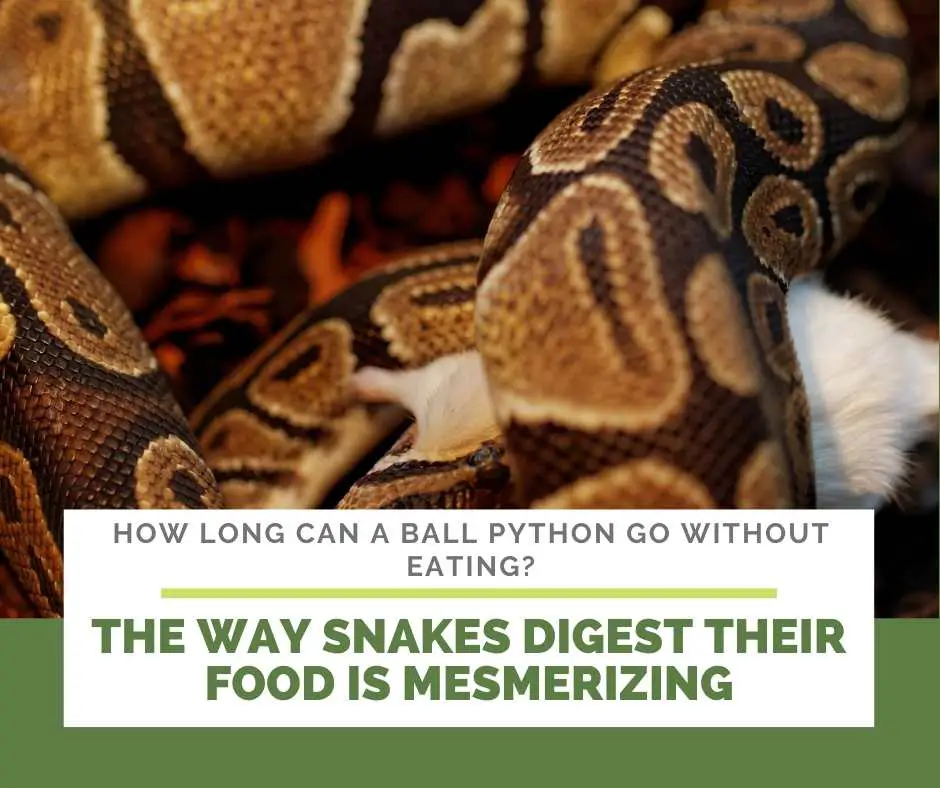
The thing with all breeds of snake is that they do not have teeth in the traditional sense of the word. Some can have fangs such as venomous snakes. The venom can have digestive enzymes that break down the food before they swallow it.
However, ball pythons are not venomous, so they use a slightly different system to eat their food. All snakes can be seen as being a long digestive tunnel. When they are active, their digestive system is not and visa-a-versa.
From Mouth To Stomach
Snakes’ jaws are designed to gulp down food in a somewhat continuous motion, even though it takes a long time until they finish eating. Their bottom jaw has two parts to it to help move the food throughout the entire digestive system that starts at the mouth.
They coat the prey in their saliva with digestive enzymes, regardless of whether the snake is venomous or not. Snakes’ esophagus (the tube that makes the food travel to the required areas) has a lot of muscles, and it is very long.
This is how the food can travel from the mouth of the snake to the stomach. The ribs also help to move the eaten prey along. The final stop is the stomach, where the meal is completely broken down even further.
They Cannot Eat Too Much.
The snake will digest everything except for hair and claws. However, snakes have to measure how much of the prey they can eat. While they can eat an entire body, this will not be good if it is too big for them. In that case, they would throw it up.
This is because the food, especially if it is too big, can rot inside its bodies while digesting it. Rotting food inside their bodies can lead to a lot of harm, even death. This is called Distension (a ballooning effect).
Other Factors of Digestion
Exciting facts when it comes to snakes is that they can eat up to 25 percent of their weight. But pythons can eat more than 25 percent of their weight and eat up to about 65 percent.
However, the bigger the meal, the more time to digest, and the more likely it is to rot. Rotting food can result in the snake throwing it back up. But other factors can also influence whether a snake vomits or not.
If they are stressed, or the temperature is too low for them to finish digesting their food. There could also be other types of health problems, causing them to vomit.
Source: https://animals.mom.com/how-do-reptiles-digest-12312600.html
The Amount Of Time Snakes Eat In The Wild Depends On Them
Another thing when it comes to snakes is that they are like humans when it comes to food. Not only do they like a variety, but certain portions as well.
Some snakes can eat small amounts of prey throughout the day, while others only want to devour one huge meal now and then. Like people, some can eat small snacks while others have a huge meal, and both are fine.
However, snakes that eat less often (like the ones that prefer one huge meal) livers, heart, and intestine can express growth when they have a meal. Plus, they can take in about 60 times more oxygen.
Ball Pythons Have Other Awesome Survival Skills
Being a snake seems to take a lot of hard work to the outside eye. But they make it look easy since it is for them. They are cold-blooded. They get their heat from the sun (or lamps if they are pets) since their bodies cannot create heat.
Even though they are cold-blooded, their body’s temperature can match the area that they live in. This means that if the temperature drops (like in winter), they could die from the cold. Therefore, they find a warm cave and sleep the winter away.
If a bear were to act like a snake, they would most likely starve, or their skin would be ripped off due to sliding around on a coarse surface. Snake’s bodies are a wonderland of how it works well with what others would view as disadvantages like the lack of arms.
Shedding
There is shedding, but that is due to their bodies growing, not to them sliding around. When they shed their skin, they also get rid of the parasites on them. This does sound convenient, instead of picking them off one by one, and their skin after shedding is new.
Hunting
Regarding hunting, many snakes (like the ball pythons) are nocturnal. This means that they hunt at night when the visibility is low. It gives them a chance to quickly and quietly sneak up to their prey.
Since it is dark, it is hard for snakes to be spotted, giving them enough time to prepare for a well-executed lunge. They would grab their prey with their quick movements (like a slide of hand). Snakes can see in the dark due to several factors such as:
- Some snakes can have heat vision
- All snakes can sense vibrations
- All snakes have a type of movement detection
This makes them masters at hunting at night. Plus, they are low to the ground, so they can hide in the long grass. If their prey hears something, they could easily think it was the wind.
A snake’s mouth is an escapable death tube. They have tiny “teeth” that grip their prey into place. These “teeth” actually point into their mouths instead of down like ordinary teeth tend to do. This helps them to move their food down their body to the stomach.
Can I Force My Ball Python To Eat?
You know what they say about desperate times? Well, if need be, then you can force them to eat. However, before you start on this crazy adventure, check-in with your vet or a snake expert if you should.
With Force
Force-feeding is one of the ways that you can get your pet snake to start eating again. However, you should never use this on a dehydrated snake. To tell if they are, their skin would look like it has wrinkles and clusters.
If they are dehydrated, then you should soak them in the water a few times a day. You can also make a humidity box with a hole them to climb in and out of. A bowl of water would not hurt either. If they look the same, there may be something more serious, and off to the vet, you go.
If your snake looks fine then give force-feeding a shot. You can feed them a mouse’s head with tweezers. Or you can use a syringe with a portion of mashed up cat food. This might answer the question how long can a ball python go without eating.
Mouse’s Head
First, you would cut off the head of a mouse and pick it up using tweezers. Then take your snake by holding them at the back of their head and gently pressing the mouse’s head against their lips until they open up. If they go not swallow, use a thin steel stick to push it down.
From here, you would push the head down and pass the neck of the ball python. Once it has passed there, you gently massage their body until the food reaches their stomach. It is a third of the way down. Then leave them alone in a warm area, so they can digest.
Using A Syringe
Take a small syringe (about 3 to 5 ml) and fill it with either liquefied cat food or a beaten egg mixed with vitamin and calcium powder. Once ready, take your ball python by the back of their jaw and gently press on both sides to open and keep the mouth open. You can wet their lips with water.
Insert the syringe until it passes their neck. Empty the contents and then remove the syringe to close their mouth and keep it for a few seconds if they want to vomit. Then place them in a warm spot and leave them.
What Else do I Need to Know About Feeding Ball Pythons?
A pet snake is different from that of a snake in the wild. Pet snakes cannot go out and hunt for their food, and they rely on you to find them. The number of times you should feed your adult ball python is usually once every ten to two weeks.
What And How Often To Find Them
Baby ball pythons should be fed more often since they are still growing. Therefore, a meal every five, or six, or seven days is the aim. The number of days will depend on your baby snake, so keep an eye on them and figure out their pattern.
Pet ball pythons food of choice is anything that has a lot of protein in it. They are carnivores and use the protein to give themselves the energy to eat their meals and digest it. Their food can be hamsters, gerbils, but their favorite (and the easiest to get) are mice or rats.
Some ball pythons could munch down pre-killed mice, others could handle frozen ones. It is best to check with a specialist regarding your scaly friend since every ball python is different. Hence, the variety of days you can feed a baby one.
However, you can not change their diet. You can change the number of times you feed them. More when they are a baby and less as an adult. But you cannot change what you feed them. They need a high level of protein, so adding greens will not be noticed by them.
Plus, some ball pythons are just picky eaters that will not eat unless it is to their standard.
No Touching While They Digest
As a reminder: snakes need time to digest their food. Therefore, you should not pick them up and start playing with them within two days of feeding them. This may freak them out, causing them to throw up.
Vomiting is not good, but what is worse is their stomach acid. It is very strong, and it can hurt you or the outside of their bodies. So just watch them as they digest for two days and then play with them a bit.
Conclusion
This concludes the question how long can a ball python go without eating. I hope I answered your question.
Ball pythons can go for six months without eating. But pet ones should not have to. However, if you notice that they are unwell and have not gotten any better, it is best to take them to the vet as soon as possible.
